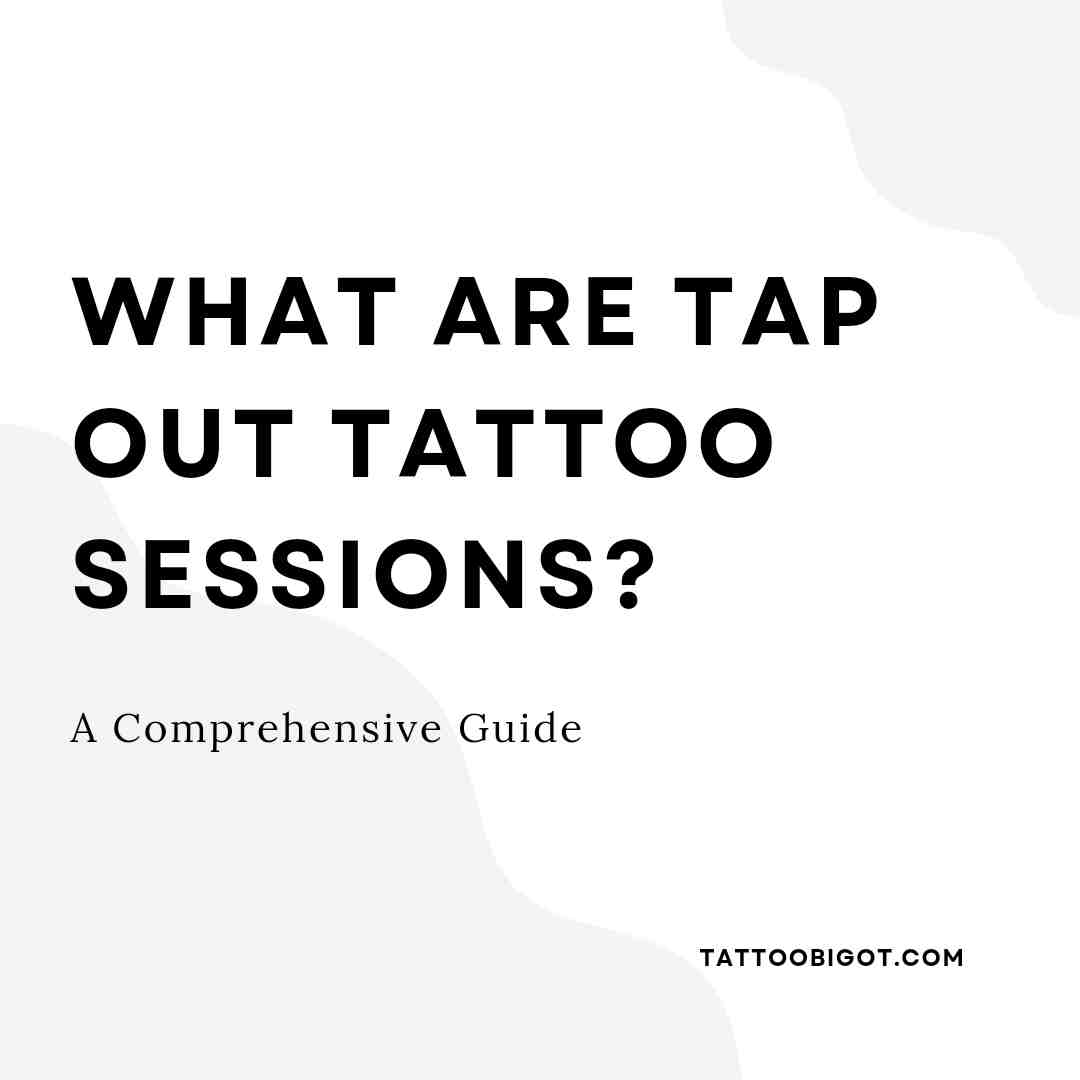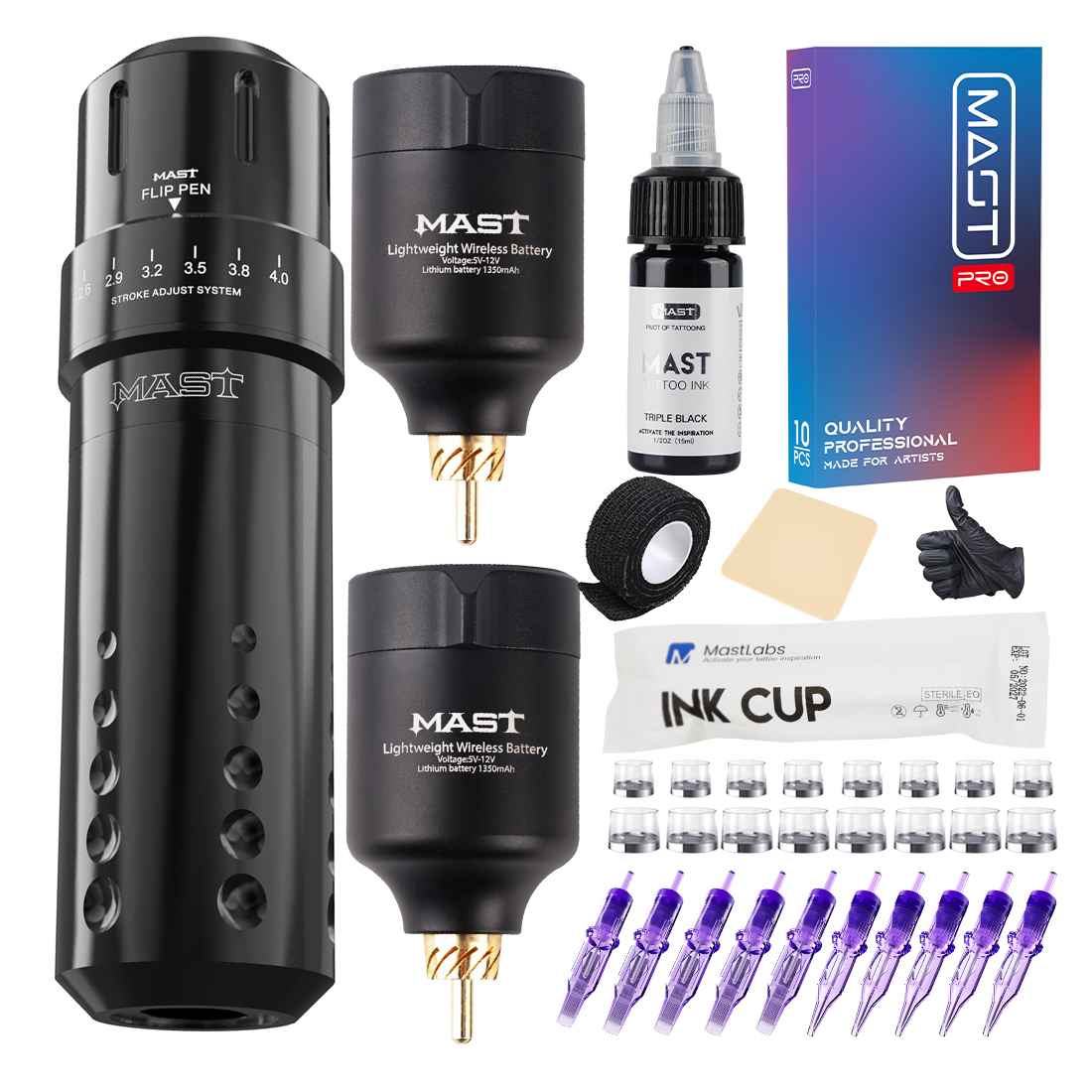Getting an extensive, highly detailed tattoo can involve many long sessions in the artist’s chair over weeks or months.
This requires dedication from both the client and tattooer. Some studios now offer “tap out” sessions as an alternative experience for hardcore collectors looking to ink large or full-body pieces.
But what are tap out tattoo sessions exactly? In this comprehensive guide, we’ll explain the tap out concept, what to expect during these marathon appointments, the risks involved, and how to prepare for this intense tattoo experience.
The Basics of Tap Out Tattoo Sessions
A “tap out” session refers to an ultra-long appointment where the client receives continuous tattooing until they can no longer endure the discomfort and tap out, or ask to stop. This allows the artist to work for 5, 10, 15 hours or longer in one sitting.
These sessions let the artist focus deeply on a large, cohesive tattoo without interruptions across multiple appointments. The extended time under the needle also enables them to pack intense detail into the work.
Instead of taking weeks off between shorter sessions, the tattoo’s foundation is built in one power session. The client then returns later for any touch-ups and shading.
Tapping out ends the marathon appointment when the pain becomes unbearable. It takes an extreme level of stamina and commitment from both the artist and the client.
Origins of Tap Out Tattoo Sessions
Tap out sessions emerged from the “Meat Grinder” appointments sought out by die-hard collectors looking to be fully immersed in the tattoo experience.
Legendary artists like Filip Leu pioneered the concept in the 1990s within the underground blackwork community. It was seen as the ultimate test of strength and willpower for client and artists alike.
Over time, more studios began offering tap out sessions upon request to tattoo enthusiasts hungry for full, detailed pieces. They remain popular in the Neo-traditional American and Blackwork styles that feature intricate designs.
Also Read: How Long Does a Chest Tattoo Take? Factors that Impact Session Length
What Happens During a Tap Out Session?
Here’s an overview of what typically takes place throughout an intense tap out tattoo session:
1. Consultation
The client consults in advance with the artist about design ideas and books the full-day appointment, often lasting 10-12 hours. Non-refundable deposits are usually required.
2. Set Up
On session day, the artist prepares their full workstation and readies equipment and inks for the long haul. Extra needles, grommets, paper towels, and supplies are laid out nearby.
3. Outline
The main outline defining the major shapes and elements of the full design is tattooed first in long fluid motions. This provides the foundation.
4. Shading
After the outline is complete, the artist begins adding shading, texture, dotwork, and dimensional elements like background patterns.
5. Enduring the Pain
As hours go by, the soreness intensifies. Light conversation helps distract from the discomfort. Short breaks may be taken occasionally.
6. Tap Out
Eventually, the client reaches their pain threshold and asks to stop by tapping out. The artist immediately concludes for the day. Average tap out times range 5-15 hours.
7. Aftercare
After the grueling session, thorough aftercare instructions are provided to begin healing the expansive fresh tattoo. A follow-up appointment is scheduled.
8. Touch Ups
A second, shorter session perfects any missing spots and ensures crisp lines, vibrant colors, and smooth shading blends. Additional sessions may follow.
What are the Benefits of Tap Out Sessions?
For suitable clients, tap out tattoo sessions offer these advantages:
- Allows larger scale pieces to be started and finished sooner.
- No interruptions in design flow compared to shorter disjointed sessions.
- More time for the artist to pack in detailed work and advanced techniques.
- Deeper meditative-like experience being “in the zone” for hours.
- A greater sense of earning the tattoo through enduring the full process.
- Eliminates the anticipation anxiety leading up to future sessions.
- Bonds artist and client through the shared intense experience.
- Provides bragging rights and recognition in the tattoo community for sitting through legendary sessions.
In the right circumstances, tap out sessions can result in stunningly detailed pieces thanks to the extended concentrated artwork.
Also Read: How Long Do Glitter Tattoos Last? A Look at Their Duration
What are the Risks and Downsides of a Tap Out Tattoo Session
While rewarding, tap out tattoo sessions are not entirely free of risks. They do come with some cautions:
- Extremely high levels of pain over many continuous hours. The discomfort is taxing physically and mentally.
- Increased risks of bleeding if blood thinness occurs after prolonged tattooing.
- Greater likelihood of ink blowouts without proper breaks to let swelling go down.
- Higher chances of making mistakes when an artist gets fatigued after hours of precision work.
- Poor healing if a client is not vigilant about aftercare for the oversized tender tattoo.
- Bing unprepared for the grueling experience and having to tap out after only a few hours.
- Costly non-refundable deposits lost if appointments are missed or rescheduled.
For these reasons, tap out sessions are not advisable for the average tattoo recipient. They require extraordinary commitment.
Is a Full Tap Out Session Necessary?
While legendary in the tattoo world, going the full tap out route is not mandatory for getting large detailed work. Less intense options include:
– Multi-session pieces – Breaking up a major tattoo over 4-6 modest 3-5 hour sessions is more tolerable for many people.
– Partial tap outs – Trying a 5-6 hour tap out session gives a sense of the intensity without a 10-hour first-timer ordeal.
– Smaller single pieces – Starting with a 2-4 hour one-sitting tattoo eases into longer appointments later.
There’s no shame in working up incrementally to longer sessions based on your personal pain tolerance and recovery ability.
How to Prepare for a Tap Out Tattoo Session
Preparing mentally and physically maximizes your chances of completing an epic tap out under the needle:
1. Mindset
- Reflect on your tattoo motivations and goals for the long-term piece.
- Visualize yourself persevering through the discomfort during tough moments.
- Understand your pain tolerance limits so you know when to tap out.
- Embrace the struggle as an opportunity for growth.
- Remind yourself that pain is temporary but the reward is permanent.
2. Physical
- Arrive well-rested, hydrated, and have eaten a meal high in protein and complex carbs for sustained energy.
- Avoid alcohol, caffeine, anti-inflammatories, and blood thinners for 24-48 hours pre-appointment since they can increase bleeding risks.
- Take a few days off beforehand from strenuous activity so your body isn’t exhausted.
- Get a solid night’s sleep to be well-rested.
- Wear comfortable clothing you can sit still in for hours and easily expose the tattoo area.
3. Supplemental Aids
Some additional options that may help (use only as recommended by your artist):
- Sugar-free candies or gum to keep blood sugar up.
- Cooling gel packs to soothe pain between sessions.
- NUMB520 topical anesthetic applied ahead of time.
- Music, podcasts, audiobooks to listen to through headphones.
- Stress ball to squeeze.
- Sunglasses to cover eyes while lying face down.
- CBD oil for calming effects without THC.
Also Read: Can a Physical Therapist Have Tattoos? Find Out Today
What to Expect Pain-Wise During a Full Tap Out
To mentally brace for a tap out, expect the pain to build and peak in stages:
– First 1-2 hours – Sharp sting fades into a vibrating hot scratching sensation.
– Next 2 hours – Burning, throbbing soreness intensifies.
– Hour 4-8 – Pain reaches an extreme peak but eventually plateaus as endorphins kick in.
– Hour 8+ – Overwhelming soreness and physical exhaustion set in. Mental focus becomes vital.
– Final hour – Excruciating sensitive skin can induce nausea, and claustrophobia. Tap out imminent.
Staying centered through the suffering while embracing the experience allows you to tap out without regret when ready.
Choosing the Best Areas for Tap Out Tattoos
Some placement options are better suited than others for multi-hour sessions:
Back – The broad canvas allows large designs and the prone position gets uncomfortable slower. Meaty areas can withstand prolonged work.
Thighs – Relatively low sensitivity levels let sessions go longer. Cushioned legs prevent pressure sores while lying.
Chest – Provides ample surface area for detail. The reclined chair position offers some relief between passes.
Arms – No sitting on them reduces circulation loss, but fragile wrists and elbows require caution over time.
Abdomen – Intricate centerpieces work well here but the tender skin often provokes an earlier tap out.
Avoid bony prominences with little padding or highly sensory regions like feet for your first tap out.
Ideal Tattoo Styles and Designs for Tap Out Sessions
Certain tattoo styles shine through extended appointment times:
Blackwork – The intricate patterning and textures demand time for precision. Solid black ink provides high contrast.
Dotwork – Thousands of pinprick dots can be painstakingly added over hours to create stunning shading.
Geometric – Symmetrical shapes and mathematical alignments emerge sharply after prolonged focus.
Mandala – Complex layers of ornate filigree flourish through meticulous meditation-like rendering.
Neo-Traditional – Bold outlines and bright colors suit this style’s retro flair. Long hours allow rich vibrancy.
Portraits – Lifelike faces with photorealistic detail are made possible thanks to artistic endurance.
Aftercare for Tap Out Tattoos
After a brutal tap out session, diligent at-home care is crucial for proper healing:
- Closely follow the artist’s aftercare sheet instructions for cleaning, moisturizing, and protecting the mammoth tender tattoo.
- Expect more oozing, scabbing, and peeling than smaller pieces. The skin has been severely traumatized.
- Avoid picking scabs so large areas don’t lose ink and require touch up.
- Watch closely for signs of infection like pus, redness, heat, and see a doctor promptly if concerned.
- Keep the area covered with non-stick bandages and avoid friction from clothing.
- Resist the urge to show off the tattoo until it fully heals to prevent contamination.
- Avoid sun exposure, swimming, and contact sports during recovery.
- Be extremely gentle when washing and applying ointments to the oversized sensitive tattoo.
- Follow up with your artist so they can check progress and address any problem spots.
Full heal time may take 4-6 weeks. Refrain from future tap out sessions until you’re confident the current piece has mended completely.
Finding Tattoo Artists Experienced With Tap Outs Tattoo Sessions
Marathon tap out sessions should only be attempted under the most qualified artists. Seek out professionals exhibiting these traits:
- A considerable depth of experience specifically with large scale single-sitting tattoos. Ask to see healed examples.
- A style and technique particularly suited to detailed designs requiring prolonged time under the needle.
- A calm, focused mindset that responds well to the mental pressures of hours of nonstop precision tattooing.
- Strong communication skills to coach you through the grueling process and spot signs of excessive pain.
- An immaculate studio with elite-level health, safety, and hygiene practices.
- A reasonable policy on deposits that will be applied to the total session cost, rather than lost entirely if you tap out early.
- A passion for collaborating with clients to create monumental tattoos through the ultimate test of willpower.
While any artist can theoretically do a tap out, those who embrace the extreme nature of this tattoo experience make the best guides through your epic journey under the needle.
Conclusion: What are Tap Out Tattoo Sessions
From its underground Meat Grinder roots to prominent studio offerings today, the tap out tattoo session represents the pinnacle of tattoo culture for some ink enthusiasts. The hours of continuous work allow large, stunningly detailed pieces to emerge in one grueling sitting.
However, the extreme pain and length of these sessions render them unsuitable for most clients. Mentally preparing for the challenge, choosing the right tattoo styles and locations, and maintaining rigorous aftercare can make the tap out experience rewarding rather than regrettable.
For those able to withstand reaching their limit under the needle, the sense of strength gained and bonds forged with the artist prove unforgettable. But only by reflecting honestly on your pain tolerance and commitment can you determine if you’re ready to attempt the ultimate tap out tattoo session.
I hope this article on, “What are Tap Out Sessions” has been helpful? Kindly share with your friends and family.
Frequently Asked Questions
How long do most people last during a tap out session?
Average first-timer tap out sessions range from 5-15 hours. Veteran clients sometimes reach 20-30 hours. Pain tolerance varies tremendously from person to person.
How soon can I get tattooed again after tapping out?
Allow an absolute minimum of 2 weeks for the body to recover before any repeat sessions. Most artists recommend waiting 4-6 weeks though for proper healing.
Can I get a small tattoo the day after a tap out session?
No, refrain from any tattooing until the current large piece heals fully. The body needs time off to recuperate after the extreme stress.
Do tap out sessions cause more scarring?
Not inherently, but poor aftercare leading to complications like blown-out ink may require touch-ups that increase scar tissue build up over time.
Can I get a discount if I have to tap out early?
Depends on the shop. Some apply deposits to the final session cost. Others institute minimum session lengths to qualify for discounts. Ask beforehand.
Should I avoid drinking water during really long sessions?
No, stay well hydrated. Just use the restroom as needed. Stopping fluid intake raises health risks from dehydration and electrolyte loss.
Can I do multiple tap out sessions in one week?
Not recommended. Space sessions at least 4-6 weeks apart, longer if still healing. The body and immune system need ample recovery time.
How do I choose a design suitable for a tap out tattoo?
Consult your artist for the best options, but styles requiring detail work like blackwork, dotwork, and portraiture often benefit most from prolonged sessions.
Is it ok to take short breaks during a tap out session?
Yes, good artists will suggest occasional 5-10 minutes breaks to stand up, get snacks, and use the restroom. This helps you recharge.
Should I eat a big meal right before a long session?
No, eat a light meal 2-3 hours prior so you don’t get nauseous. But bring snacks, juice, and water to keep your blood sugar up.






